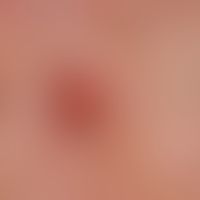Image diagnoses for "Scalp (hairy)"
120 results with 343 images
Results forScalp (hairy)

Actinic keratosis L57.0
Keratosis actinica, keratotic type: extensive "field carcinization" of the scalp, beginning transformation into an invasive, spinocellular carcinoma (here detailed picture).

Primary cutaneous follicular lymphoma C82.6
Primary cutaneous follicular center lymphoma: For several years training of surface smooth, painless, plaques and nodules.

Acne conglobata L70.1
Acne conglobata: Detail view with deeply sunken scar fields; isolated brown comedones.

Acne conglobata L70.1
Acne conglobata: symmetrically distributed, eminently chronic, inflammatory melting, papules and pustules as well as strong, retracted scarring; image resembles the cutis vertivis gyrata.

Acne conglobata L70.1
Acne conglobata: symmetrically distributed, eminently chronic, inflammatory and melting papules and pustules as well as strong, retracted scar formation, with retention fluctuating in places.

Tinea capitis profunda B35.02
Tinea capitis superficialis: easily inflammable, blurred, alopecic focus in the occipital region in a 7-year-old boy. low crust formation. no itching. no pain. fungal culture: Trichophyton mentagrophytes.

Pachydermoperiosteosis, primary M89.4
pachydermoperiostosis, primary: A 32-year-old man of Han Chinese origin presented with a 15-year history of a peculiar facial appearance (Panel A). after puberty, he had noticed a progressive enlargement of his hands and feet as well as facial furrowing. the patient reported that the progression of disease had stabilized by the time he was 27 years of age. on examination, he had excessive sebaceous secretions and thick, furrowed, and redundant skin on his forehead, cheeks, and chinese. soft-tissue hypertrophy reduced the motion of his hands and feet, with terminal broadening of the fingers (Panel B) and toes and cylindrical enlargement of the limbs. the patient received a clinical diagnosis of pachydermoperiostosis, a rare genetic disease characterized by pachyderma, digital clubbing, and periostosis. his parents and son did not have similar symptoms; no genetic testing was performed. the therapy was performed in two stages. in the first stage, we implanted an expander under the patient's forehead skin to enlarg

Psoriasis capitis L40.8
Psoriasis capitis: chronically inpatient red and white plaques, localised on the forehead and capillitium, reaching far into the hairy area, sharply defined. currently, after insufficient pre-treatment. further red plaques on the elbows.

Nevus sebaceus Q82.5
Sebaceous nevus: 25-year-old man; the reddish-brownish plaque, interspersed with whitish papules, was completely painless since birth; the excision was performed without complications and without spindle; a sebaceous nevus could be histologically confirmed.

Alopecia marginalis L65.9
Alopecia marginalis: 45-year-old woman, who has been fixing the curly hair on the top of her head with 2 crossed hair clips for years. In the area of the hair clips now circumscribed hairless plaque with slight induration and coarsening of the skin surface. A histological examination was performed to exclude other causes.

Fibroxanthoma atypical C49; D48.1
Fibroxanthoma atpyisches: flat ulcerated lump in a man (84 years), clearly visible in actinically damaged skin.

Keratosis actinica keratotic type 57.00
Keratosis actinica, keratotic type: In a 75-year-old male patient, adherent keratotic plaques have increasingly developed over the last few years, the mechanical detachment of which is painful; here flat ulcers, crusts, scars.

Cornu cutaneum L85
Cornu cutaneum: 73-year-old man. considerably actinic damaged skin. numerous actinic keratoses and lentigines. the narrow-based "skin horn" has existed for at least 6 months.











